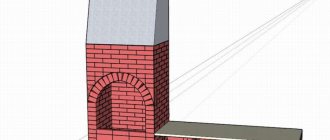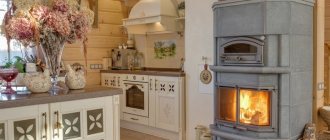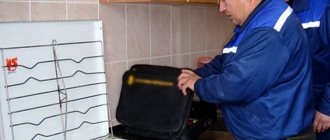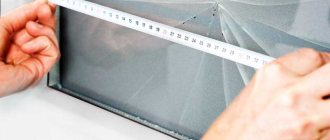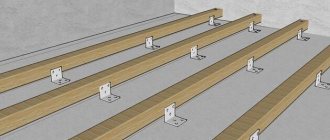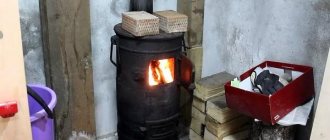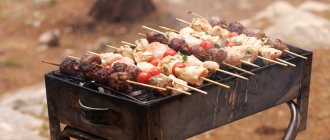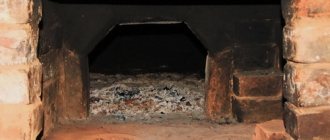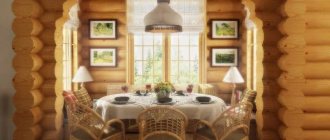Our family recently purchased a village house that has a stove. We had never used one, so we found a stove-maker grandfather in the village. He talked about the types of firewood (which ones are better to burn and which ones are worse) and gave some more tips on how to use the stove so that it serves for a long time. We learned a lot of useful things from him, thanks to him!
As it turned out, if you handle the stove and firewood correctly, you can reduce fuel consumption by 15-20 percent. You can also improve heat transfer and prevent increased soot formation in the chimney. At the same time, the service life of the stove largely depends on following the rules.
What kind of firewood is preferable?
It is best to take firewood from hard, deciduous trees. When they burn, no resin is released, and the high combustion temperature is maintained without problems. An additional advantage is that soot remains to a minimum inside the chimney.
It is not advisable to heat the stove with garbage; it is also bad to use spruce and pine wood. On the contrary, it is good to heat with sawdust. Briquettes are also used; they are made from peat or wood. The fuel should have a moisture content of about 20 percent. It is present if the firewood is stored in a dry room for a year.
Don't Compromise: How a Boss Can Deal with Very Difficult Employees
Avoid Aggression: Tips on how to communicate with a variety of people in the office
Should we want to be better than others: why money won’t make us happy
Independent and reliable
The main advantage of the TeplEko heater is its independence. The optimal temperature that it should maintain in the room can be set using a thermostat. And that’s all - it will work, creating an atmosphere of real homely, “lived-in” comfort, when you can play with children on the floor, sleep peacefully, tossing and turning, no matter how frosty it is outside the windows. The TeplEko heater is ideal for a summer house, garage or office. It is useful where there is no central heating supply, or where the price of steam heating makes the consumer think about the advisability of living in a cold climate.
is the only manufacturer in Russia of such energy-saving heaters made of highly purified sand. You can buy a heater in a company store or order delivery by phone. And to install the heater you will need a minimum of strength and skill, three self-tapping screws and a screwdriver.
And let the simplicity of the heater not raise any doubts about its durability. As you know, everything ingenious is simple. And the TeplEko heater can work almost forever, because its heating elements do not come into contact with air and do not oxidize. The warranty is 5 years, and the service life is unlimited.
Promotion until October 15!
8-800-333-05-35 (toll-free in Russia)
www.tepleko.ru
As an advertisement
What type of wood is best for firewood?
Different types of wood differ from each other in their calorific value and combustion characteristics. In this regard, when choosing fuel, you need to understand the performance characteristics of firewood.
- Pine has a high combustion temperature. The reason for this is the high resin content. This rock suggests many voids where tar deposits are present. When burning, they produce micro-explosions, sparks and ignited pieces of wood fly away.
- Spruce is less efficient in a firebox than pine. It contains less resins. Splitting wood is easy, but when burning the tree smolders and smokes. These conifers can be used for heating only in extreme cases.
- Alder. The main feature is the ability to burn without forming soot. At the same time, during combustion, deposits in the chimney will also be burned out. Such characteristics are unique to aspen.
- Poplar. It burns out quickly without providing enough heat. It should not be used to heat a bathhouse, but it is quite suitable for a home.
- Birch. Burns hotter than beech with acacia and oak. But there is also a drawback, and a significant one. It is necessary that there is sufficient air flow into the combustion chamber. Otherwise, there will be no heat, but only tar and smoke on the walls of the chimney.
- Oak. It is distinguished by its high density and ability to release heat. Its characteristics are similar to ash and also resemble beech. Oak wood is quite heavy when splitting.
- Maple. Its wood burns quickly without forming coals, as a result, there is a need to constantly add fuel. It's like burning linden wood.
- Apple trees. Like other fruit species, it pricks well and produces enough heat when burning. Apple firewood is also preferred because of the pleasant smell in the room.
Here's what else the stove maker said.
A third of Russians agree to submit biometric data: how is collection done?
Use time profitably: why it’s worth working part-time when you have a salary
This is how customers trust more: reasons to market in simple language
Garden stove for a summer residence: arrangement and design features
If you don’t want to deal with the chimney, you can take the cooking stove outside. Garden hearths have a simplified design and do not require smoke circulation channels. Their only job is to heat up the stove and oven. To remove smoke away from people and the house, the building is supplemented with a low chimney. There are garden models on sale made from modern fireproof materials and metal, but if you wish, it will not be difficult to quickly put together a simple structure from brick with your own hands.
The proposed arrangement can be used both for building a cooking stove in the garden and for laying a stove in a summer kitchen. The construction of a fireplace indoors involves connection to a chimney or pipe. Thanks to the side gas outlet, there is no need to break the ceiling to remove the chimney. It is recommended to build a low chimney on the street, and make a protective canopy for the stove to protect it from precipitation.
Arranging a compact stove for a garden or summer kitchen
To build a small and simple stove you will need about 250 bricks, an oven, a firebox door and a cleaning hole. This model includes a water heating tank, but if desired, it is easy to exclude it or, conversely, improve it by replacing it with a heat exchange tank. It is recommended to connect the heat exchanger to the tank in the shower - with this method the efficiency of the fireplace will increase significantly.
What are the alternatives?
In addition to the types of wood listed above, peat briquettes are popular. Their advantage is that they do not need to be chopped, dried or otherwise prepared for burning.
Sawdust can be used instead of lump wood. But you still need firewood. With their help, kindling is carried out, followed by sawdust, which should make up no more than a third of the total volume of fuel.
Wood-fired heating boilers
Of course, today quite a lot of people consider wood-burning boilers to be a kind of relic of the past and wonder what could be the reason for using them to heat a house. In fact, there are several reasons. The main one is the inability to connect a gas pipe to the house (there is no gas main nearby) or the impossibility of supplying fuel of a different type (not firewood).
What heating is better for the home?
The use of electric boilers is excluded due to fairly stable power outages. And it turns out that heating a dacha with wood is the only real way to heat a house.
Vintage solid fuel boiler
What is best to use for cleaning a chimney?
Chimney maintenance needs to be done periodically. Soot and resin deposits are removed from it. There are following reasons for this:
- The internal lumen becomes overgrown, causing traction to deteriorate and, accordingly, heat transfer decreases.
- If there is insufficient draft in the chimney, then a reverse draft effect may occur. Instead of going outside, the smoke will return indoors, which is the cause of carbon monoxide poisoning.
- Having reached a critical level, the soot ignites. Essentially, a micro-explosion occurs inside the chimney. During combustion, a lot of heat is released and heating occurs up to 1200 ° C. Then the chimney requires major repairs.
To prevent the condition of the chimney, among other things, in case of small deposits, burn aspen or alder firewood. The oven needs to be heated thoroughly. In addition to firewood, briquettes that have a special chemical composition are also used. However, if there are large soot deposits inside the chimney, burning off the tar will not help. Then mechanical cleaning of pipes is inevitable.
Stove based on the bio-fireplace principle: not a cloud of smoke
Fireplaces running on biofuel do not require a chimney and perfectly decorate the interior of not only cottages and country houses, but also city apartments. However, there is practically no heat from a beautiful flame - biofireplaces have very low thermal efficiency. To meet the demand of consumers who wanted not only spectacle, but also a heating effect, inventors came up with stoves that could work indoors without chimneys.
Heating stove without chimney using biofuel
The design consists of a thermally insulated open casing, the inner walls of which are covered with fire-resistant reflective material. Thanks to the reflector, the heat transfer coefficient increases significantly. Insulation prevents excessive heating of the external walls, which allows the device to be installed next to furniture and decor. At the bottom there is a ceramic burner. Ethanol is used as fuel.
Unfortunately, it is still problematic to buy a stove of this design, but craftsmen using this invention are already making stoves without a chimney with their own hands. If you use a heat-storing material instead of a heat-insulating material, the device will heat even after the flame has died out.
How to heat correctly?
To reduce wood consumption and improve combustion, the stove maker advised doing the following:
- You need to put logs into the stove that are approximately 5 cm shorter in size than the length of the firebox. If, when preparing firewood, you make it approximately the same size, it will be much easier to burn.
- The logs are laid in such a way that there are gaps for air.
- Although the stove can, in principle, be heated with raw wood, this is fraught with the release of tar with smoke and in considerable quantities. In this regard, it is better to deal with dry fuel (no more than 25 percent humidity).
And finally - about how to start lighting the stove.
Business and finance: industries where age discrimination is widespread
How to Become Successful: Be Hardworking and Moderately Talented and Lucky
Passive recruiting: what is it and how to competently entice a specialist
Metal wood stoves: compactness and mobility
The dimensions of heating stoves made of cast iron and steel are several times smaller than the size of the Russian stove, but they are practically not inferior to their bulky predecessor in efficiency. Modern metal hearths work on the principle of convection - they quickly heat the cooled air entering special channels, which, having reached the desired temperature, rises and mixes with the air masses.
Convection appliances do not require smoke circulation channels - it is enough to take care only of the smoke exhaust pipe. An asbestos or steel pipe is suitable as a chimney for a “potbelly stove”, which is not difficult to make with your own hands. For “buleryan” type structures, it is recommended to use a chimney made of asbestos or ceramics.
The metal hearth just needs to be connected to the chimney pipe. Compact heating model with stove
For maximum comfort at the dacha, it is best to install heating and cooking modifications; they allow you not only to heat up, but also to prepare a full meal. In addition to the kitchen stove, many products are equipped with functional ovens.
How should you light the stove?
Lighting a stove can be considered a kind of art. If you do this incorrectly, as well as ineptly maintain the fire, then it will be impossible to achieve a temperature in the firebox of more than 40-50 ° C, and this is not enough to heat the room. Kindling involves the following steps:
- Preparation. It is necessary to remove ash and coals from the ash chamber and clean the grate. Then the traction is checked. This is done by lighting paper or a candle. The firebox should draw flames into itself.
- Laying the first of the fuel layers. A seed is prepared. A couple of bars need to be placed, moving them apart by 15 cm. Insert crumpled paper between them, onto which a pile of wood chips, shavings, and sawdust is poured. You need to put a couple more logs diagonally on top.
- Ignition. Use a torch or lighter to ignite the seed. The use of flammable liquids is prohibited. As for dry fuel, it is allowed with wet firewood. Ignition is carried out by opening the ash pan, waiting for a buzz to appear. The noise is an indication of a fire breaking out. The damper does not need to be closed completely.
- Additional loading of firewood is carried out 15 minutes after igniting the seed. And then the logs need to be added every 2 hours, until the temperature reaches the required level.
Found a violation? Report content
The advantage of heating with wood
In fact, wood heating is quite effective. And it should be noted that it is in no way inferior to modern types of fuel. And compared to some of them, it has a number of significant advantages:
- Using a wood stove in a country house is not just a way to heat the house. On such a stove you can easily cook exactly the same dinner as on the stove.
- a wood stove heats up very quickly - and accordingly, it also quickly begins to release heat into the room.
- Even if you decide to build a new wood-burning stove in your country house, its creation will take much less time than installing a full-fledged heating system. In addition, building a furnace will cost you much less.
However, there are several other most important advantages of wood heating. First of all, this is the cost of the fuel itself. There are often cases when dacha owners independently prepare firewood by cutting down dried trees, thereby independently regulating the consumption of firewood for heating the house. But even if you buy firewood, their cost is very low.
How to choose heating for a country house?
Firewood collection
Well, the most important advantage of such fuel as firewood is that it is one of the most environmentally friendly types. That is, the smoke from such a stove does not cause any harm to humans or the environment.
Particular attention should be paid to the purchase and storage of firewood. First of all, experts recommend purchasing firewood that was harvested two years ago - this time was enough for the wood to dry out properly and the wood density for heating.
In addition, certain storage conditions must be observed. In particular, firewood should be stored in a well-ventilated area with a minimum level of importance. Under no circumstances should water come into contact with the firewood - otherwise it will have an extremely negative effect on the combustion process.
One of the ways to store firewood
If the question arises about purchasing a solid fuel boiler that will be used at the dacha, the most rational option is to use a model with a long burning time - otherwise you will have to visit the boiler quite often to add firewood to the firebox.
In fact, boilers heating with wood appeared quite a long time ago. But the simplicity and reliability of operation still makes them very popular. Of course, modern solid fuel boilers have undergone a number of changes - their combustion chambers have become more spacious, and sometimes they are supplemented with electric heating elements. In addition, the modern market provides universal heating boilers that can operate alternately on two different types of fuel (for example, coal and wood).
Recently, external boilers have been very popular. Installed outside the building, they allow you to connect several buildings to heat your home with wood.
In addition, with the help of such equipment you can organize the supply of hot water to the house. Today, one of the best manufacturers of external boilers is the Central Boiler company, whose products are distinguished by high quality and reliability.
External solid fuel wood boiler
Disadvantages of wood heating
Using a boiler that heats a country house with wood has a number of advantages, the main ones being the environmental friendliness and availability of this type of fuel. However, such a system also has a number of disadvantages. In particular:
- In order to achieve a comfortable temperature in the house and maintain it at the proper level, you should spend a fairly large amount of firewood. That is, despite the cheapness of this type of fuel, the rate of wood consumption for heating is quite high. Therefore, in the end result, the benefit is not that great. Before you decide to install such a system, you need to calculate the firewood for heating.
- This heating system requires constant monitoring. After all, even if you fill the firebox with wood as much as possible, it will only last for three hours. That is, after a certain time you will need to replenish the amount of firewood in the firebox. But at night it’s not very convenient.
- Wood boilers have a relatively low calorific value, which, in turn, leads to a decrease in efficiency (70-80%).
- To increase the level of efficiency, wood-burning boilers are made with an increased firebox. And given that this product is made of cast iron, the boiler turns out to be very heavy and massive, which significantly complicates its transportation and installation.
Modern solid fuel boiler with an increased firebox

